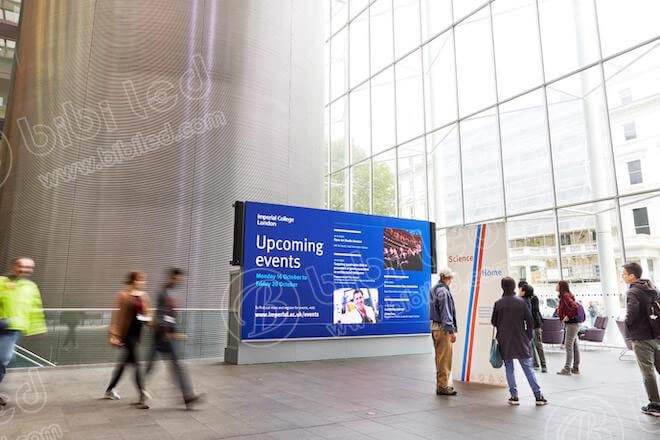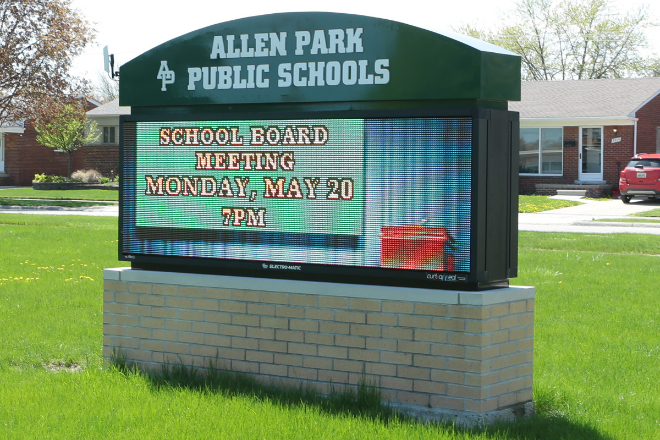Introduction

With the advent of the information age, traditional home-school communication methods can no longer meet the growing communication needs.
In this context, Écrans d'affichage LED, as a new type of information release and communication tool, have gradually entered campuses and become a new bridge for communication between schools and parents. So, how do schools communicate with parents through LED displays? Let’s read the article and find the answer together.
1. What role does the LED display play in home-school communication?

1). Information publishing platform
1.1). Main channels and real-time updates:
As the main channel for school information release, LED display screens have significant advantages. It can publish various information, such as school news, event notifications, important date reminders, etc., in real-time.
This immediacy ensures the freshness and timeliness of information, allowing parents to obtain the latest school news at the first opportunity. Whether it is the school’s daily teaching arrangements or temporary activity adjustments, they can be quickly conveyed to parents through the LED display, effectively avoiding the problem of information delay or omission.
1.2). Importance of immediacy:
The immediacy of LED displays is crucial for home-school communication. In the fast-paced modern life, parents are often busy with work and find it difficult to have the time and energy to actively pay attention to every development of the school.
The real-time update function of the LED display screen allows parents to obtain the latest information about the school when picking up their children from school or passing by the school, greatly improving the efficiency and convenience of obtaining information.
2). Enhanced transparency
2.1). Display school management information:
The LED display screen is not only used to publish daily notices but also to display key information such as the school’s teaching plan, curriculum setting, and teaching staff. The openness and transparency of this information allow parents to have a more comprehensive understanding of the school’s teaching management and teaching quality.
Parents can learn about their children’s learning content, teaching progress, and teachers’ professional backgrounds at school through the LED display screen so that they can feel more at ease when sending their children to school.
2.2). The impact of transparency on trust:
This increase in transparency is important for enhancing parents’ trust and satisfaction with the school.
When parents can clearly understand the operation and management of the school, they will have more faith in the school’s educational philosophy and teaching quality and will be more willing to cooperate with the school to promote their children’s growth.
At the same time, the improvement of transparency can effectively reduce misunderstandings and conflicts between home and school and enhance understanding and trust between the two sides.
3). Promote interactive participation
3.1). Parents are encouraged to participate in activities:
When displaying information such as parent meetings, open day activities, and volunteer recruitment, the LED display screen can intuitively present the time, location, and content of the activities, attracting parents’ attention and stimulating their enthusiasm for participation.
Through the display of the LED screen, parents can more easily learn about the school’s upcoming activities and choose to participate according to their own time and interests.
3.2). The significance of interactive participation:
Parents’ interactive participation has far-reaching significance for strengthening home-school cooperation and jointly promoting children’s growth.
When parents actively participate in school activities, they can not only gain a deeper understanding of their children’s learning and living situations but also form a closer cooperative relationship with the school and jointly contribute to their children’s growth and development.
At the same time, parental involvement can enhance children’s sense of belonging and self-confidence and promote their all-round development. Therefore, LED display screens play an important role in promoting interactive participation between home and school.
2. Specific application examples of LED display screens in home-school communication
1). Daily notification release
The school uses LED display screens to publish daily notices, which has become an efficient and intuitive way of communication.
For example, when the school’s schedule needs to be adjusted due to seasonal changes or special reasons, the administrator only needs to enter the new schedule in the background, and the LED display will be updated immediately.
Similarly, if there are changes in the school bus schedule, such as route adjustments and early or delayed departure times, this information can also be quickly conveyed to parents through the LED display.
This notification method plays a vital role in increasing parental awareness and reducing misunderstandings. In the past, parents might obtain this information through word of mouth from their children or by checking the school website, but this method often carries the risk of delays or omissions.
Now, when parents pick up their children from school, they can see the latest notifications on the LED display at a glance, ensuring the timeliness and accuracy of the information. In this way, parents can better arrange their time and plans, reducing misunderstandings and inconveniences caused by information asymmetry.
2). Special event promotion
The school holds various special events every year, such as sports meets, art festivals, science and technology exhibitions, etc.
These activities are not only a organiser for students to showcase their talents but also an important opportunity for interaction between home and school. The school promoted these activities through LED display screens, and the effect was very significant.
On the eve of the event, the school will scroll the event posters, time, location, and highlights on the LED display screen to attract the attention of parents.
This intuitive way of promotion allows parents to have a more comprehensive understanding of the event and also stimulates their enthusiasm for participation.
Some parents may not be very interested in a certain type of activity, but after seeing the promotion on the LED display screen, they will be attracted by the unique charm of the activity and decide to participate.
In this way, the participation and influence of the event were significantly improved.
3). Emergency information communication
In emergency situations, such as sudden weather changes, campus safety incidents, etc., LED display screens play an irreplaceable role.
When the weather changes suddenly, such as heavy rain, typhoons, etc., the school needs to quickly notify parents to adjust their children’s pick-up arrangements or remind their children to pay attention to safety.
At this time, the LED display screen can display the emergency notice for the first time to ensure that parents understand it in time and make corresponding preparations.
Similarly, if a safety incident occurs on campus, such as a fire or earthquake, the school also needs to quickly convey evacuation instructions or safety tips.
As a conspicuous facility on campus, the LED display screen can quickly attract the attention of teachers and students, convey emergency information, and provide strong protection for campus safety. In this emergency situation, the rapid response and wide coverage of the LED display screen provided strong support for the school’s emergency management work.
3. Precautions and suggestions for the use of LED display screens in schools

1). Content Accuracy
When schools use LED displays to communicate with parents, the first thing they should pay attention to is the accuracy of the content. Every piece of information posted on the LED display must be strictly verified to ensure accuracy.
This is because if the information is wrong, it may not only mislead parents but also cause unnecessary panic or confusion.
For example, if the school mistakenly sends out an incorrect notice about a schedule adjustment, it may cause parents and children to arrive at school at the scheduled time only to find the school gate closed, causing unnecessary anxiety and misunderstanding.
Therefore, before releasing information, the school must establish a strict review mechanism to ensure the accuracy of the information.
2). Information update frequency
The frequency of information updates is also an important factor to consider when schools use LED displays. If the update frequency is too high, parents may feel overloaded with information and unable to digest it in time.
If the update frequency is too low, parents may receive delayed information and be unable to keep up to date with the latest school developments. Therefore, schools need to reasonably set the frequency of information updates based on actual conditions.
Generally speaking, daily notifications and regular activities can be updated according to a certain time period (such as daily or weekly); emergency information or special activities need to be updated immediately to ensure that parents can obtain them first.
3). Visuals and readability
The visual effect and readability of LED display screens have a crucial impact on the effectiveness of information transmission.
If the display screen luminosité is too low, the contrast is insufficient, or the font is too small, parents may not be able to see the displayed content clearly, thus affecting the effectiveness of information transmission.
Therefore, when designing and using LED display screens, schools need to fully consider their visual effects and readability.
Specifically, schools can adopt the following design suggestions: First, ensure that the brightness of the display screen is moderate, neither too bright nor too dark, to meet the viewing needs in different lighting environments; second, choose the appropriate font size and color contrast to ensure that the text The content is clear and visible.
Finally, the typesetting and layout of the information should be designed reasonably to avoid the information being too crowded or disorganized, and to improve the readability and comprehensibility of the information.
Through these design measures, schools can ensure that the LED display screen can give full play to its advantages in information transmission and provide a more efficient and convenient channel for communication between home and school.
Conclusion
To sum up, as a new type of home-school communication tool, the LED display screen plays an important role in the communication between schools and parents, and its advantages include immediacy, transparency, and interactivity.
Through specific application examples such as publishing daily notices, promoting special events, and conveying emergency information, LED displays not only increase parents’ awareness and participation but also enhance trust and understanding between home and school.
Enfin, si vous souhaitez en savoir plus sur les écrans LED, veuillez nous contacter.
